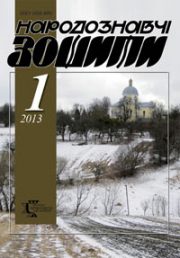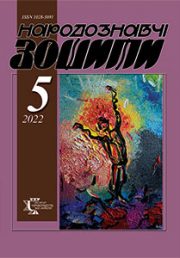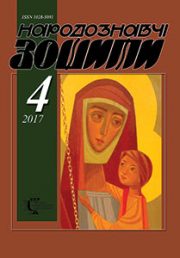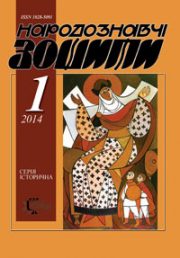The Ethnology Notebooks. 2020. № 2 (152), 293—310
UDK[ 393:[7.043:635.055]](=161.2:292.452)
DOI https://doi.org/10.15407/nz2020.02.293
THE IMAGE OF A TREE IN THE FUNERAL RITES OF THE CARPATHIAN UKRAINIANS
HOSHCHITSKA Tetiana
ORCID ID: https://orcid.org/0000-0001-8596-8974
Candidate of historical sciences / Doctor of Philosophy,
Researcher fellow of department of Historical Ethnology
of the Institute of Ethnology
The National Academy of Sciences of Ukraine,
15, Svobody Avenue, 79000, Lviv, Ukraine,
Contacts: e-mail: hoshchitska.tetiana@gmail.com
Abstract. Introduction: The tree and its alloforms are an important attribute of the calendar and family rituals of Ukrainians, in particular the Carpathian Ukrainians. However, his burial in the burial rite has so far attracted little attention from researchers, while it is of considerable research interest. Problem Statement: For the first time the peculiarities of tree life as an important element of the ritual culture of the Ukrainian Highlanders were analyzed, in such archaic part as the burial rite.
In the proposed exploration the author aims to cover the life of the tree and its alloforms in the burial rites of the Ukrainian Highlanders. Accordingly, the object of the study is the traditional family rituals of the Carpathian Ukrainians, and the subject is the tree and its alloforms, which are an important attribute of it. The main methods used by the author are structural-functional and comparative, as well as other methods of ethnological science are involved.
The connection between tree and man, the correlation of tree and man in the popular consciousness, which is particularly evident in the rituals associated with death: in the signs of early death; in the form of funeral attributes (coffin — «tree»); in the folklore motive of turning innocently killed or suicidal into a tree; in the metaphorical perception of death-path-tree; in acts of an apotropic nature during the funeral that should have prevented the subsequent deaths of the household. It has been found that, as in other rites of passage, the tree is an important attribute for the funeral of unmarried young people as a part of the symbolic «wedding» that took place during the funeral ceremonies not only of the Ukrainian Highlanders but also of the Slavs in general. The basis of these beliefs is a strong people’s conviction that the obligation of the individual to go through the basic stages of human life: birth, family creation and death. Results: At their core, these beliefs are deeply archaic and tend to be preserved even in the 21st century. However, on the example of ethnographic materials from the Ukrainian Carpathians, we can see that the ceremonial tree was an important attribute of the funeral and of the dead who were married during their lives. This custom has parallels with the flat territories of Ukraine, is extremely archaic, and judging by the nature of the recorded materials already 150 r. so it essentially disappeared. It is substantiated that the tree, in the territory of the Ukrainian Carpathians, appeared macro sign next to the later one — a cross, which imprinted on other spheres of traditional rites (in particular on various rites during the choice of a place for dwelling and selection of building material), many of which continue our time, in the context of globalization.
Keywords: traditional rituality, funeral rite, Ukrainian Carpathians, beliefs, cult of vegetation.
Received 12.03.2020
REFERENCES
Huzij, R. (2003). The Etnogfapfic Studies in the Funeral Customary of Ukrainian of Carpation Region: Some General Directions and Results of Reseach Works. The ethnology notebooks, 3—4, 272—278 [in Ukrainian].
Pol, W. (1966). Works from the ethnography of the northern slopes of the Carpathians. Wroclaw [in Polish].
Kuziv, I. (1889). The life and customs of the mountain people. The Zoria: pys’mo lyteraturno-naukove dlia ruskykh’ rodyn’, 21, 351—352 [in Ukrainian].
Zhatkovych, Yu. (2007). Ethnographic overview of ugro–russians: complex edition. Uzhhorod: Mystets’ka liniia [in Ukrainian].
Franko, I. (1898). Popular beliefs in Pidhiria. Etnohrafichnyj zbirnyk (Vol. V, pp. 160—218) [in Ukrainian].
Kajndl’, R.F. (2000). Hutsuls: their lives, customs and folk traditions. Chernivtsi: molodyj bukovynets’ [in Ukrainian].
Kolessa, F. (1898). Popular beliefs in Pidhiria in the Khodovychi village, Stryi povit, recorded by Filaret Kolessa. Etnohrafichnyj zbirnyk, V, 76—98 [in Ukrainian].
Fischer, A. (1928). Rusini: outline of ethnography of Rus. Lviv; Warsaw; Krakow [in Polish].
Falkowski, J., & Pasznycki, B. (1935). On the border between Lemko and Bojki. Ethnographic outline. Lviv [in Polish].
Falkowski, J. (1937). On the west border of Hutsylshchuna: on the wallej of Prut, Bystrzyca Nadwornianska, Bystrzyca Solotwinkia i Lomnica. Lviv [in Polish].
Kuzelіа, Z. (1915). Seating and fun at the mercy of the Ukrainian funeral rite. In ZNTSH (Vol. 122, pp. 103—166) [in Ukrainian].
Shekeryk-Donnykiv, P. (2009). The year in beliefs of Hutsuls. Verkhovyna [in Ukrainian].
Hnatyuk, V. (1912). Funeral customs and ceremonies. Etnohrafichnyj zbirnyk, ХXXI—XXXII, 133—424 [in Ukrainian].
Svientsits’kyj, I. (1912). Funeral howls. Etnohrafichnyj zbirnyk, ХXXI—XXXII, 1—129 [in Ukrainian].
Zubryts’kyj, M. (1912). Funerals customs and ceremonies in Msantsi and neighboring villages Starosambirsk and Turchany counties Etnohrafichnyj zbirnyk, ХXXI—XXXII, 211—226 [in Ukrainian].
Lepkij, D. (1890). About the skyscrapers. The Zoria: pys’mo lyteraturno–naukove dlia ruskykh’ rodyn’ (Vol. 10, pp. 150—153) [in Ukrainian].
Kmit, Yu. (1915). Funerals customs and ceremonies from bojko. In ZNTSH (Vol. CXXII, pp. 161—166) [in Ukrainian].
Huzij, R. (2007). Folk tonatology: Carpathological investigations. Lviv: In-tut narodoznavstva NANU [in Ukrainian].
Mykhajlets’kyj, O. (1912). Funerals customs and ceremonies in villagse Trostianytsy, Sniatyn district. Etnohrafichnyj zbirnyk, ХXXI—XXXII, 302—315 [in Ukrainian].
Onyschuk, A. (1912). Funerals customs and ceremonies in villages Karlovi Snyatyn district. Etnohrafichnyj zbirnyk, ХXXI—XXXII, 315—338 [in Ukrainian].
Onyschuk, A. (1912). Funerals customs and ceremonies in villages Zelenytsya, Nadvirna district. Etnohrafichnyj zbirnyk, ХXXI—XXXII, 231—252 [in Ukrainian].
Okhrimovych, O. (1912). Funerals customs and ceremonies in villages Voloshyantsy, Skilsky district. Etnohrafichnyj zbirnyk, ХXXI—XXXII, 226—231 [in Ukrainian].
Bordejvyj, I. (1912). Funerals customs and ceremonies in villages Molodiev (Molodii) Chernovetsky district. Etnohrafichnyj zbirnyk, ХХХІ—ХХХІІ, 347—362 [in Ukrainian].
Derkach, V. (1912). Funerals customs and ceremonies in villages Verbivtsi, Terebovelsky district. Etnohrafichnyj zbirnyk, ХXXI—XXXII, 369—378 [in Ukrainian].
Tarasevs’kyj, P. (1912). Funerals customs and ceremonies in villages Shebekyni, Bilhorod district, Kurs’koi hub. Etnohrafichnyj zbirnyk, ХXXI—XXXII, 403—424 [in Ukrainian].
Huzij, R., Varkhol, J., & Varkhol, N. (2002). Funerals ceremonies. In Lemkivschyna (Vol. 2, pp. 94—109). Lviv: In-tut narodoznavstva NANU [in Ukrainian].
Halaychuk, V. (2010). From the Spiritual Culture of Bohorodchany Region: Customs, Beliefs and Legends Related to the Conceptual Representation of Death and the Dead. Mythology and Folklore, 3—4 (7), 27—49 [in Ukrainian].
Krasykov, M. (2015). The death of death (before the understanding of Ukrainian national thanatologia). In Folk culture of Ukrainian: life cycle of people (Vol. 5). Age. Death. Culture of worshiping the dead) (Pp. 173—206). Kyiv: Duliby [in Ukrainian].
Voitovich, N. (2015). Folk Demonology of Boykivshchyna. Lviv [in Ukrainian].
Agapkina, T.A. (1994). South Slavic beliefs and rituals associated with fruit trees, in the general Slavic perspective. In Slavic and Balkan folklore (Ethnolinguistic study of Polissya) (Pp. 84—110). Моscow: Indrik [in Russian].
Zelenyn, D.K. (1937). Totem trees in the legends and rituals of the European peoples. Моscow; Leningrad: Izdatel’stvo AN SSSR [in Russian].
From the Carpathian Mountains. Ukrainian folk-ballads (1981). Uzhorod: Carpathian [in Ukrainian].
Onischuk, А. (1909). Materials to the Hutsul demonology, written in 1907—1908 in Zelenitsy, Nadvirna district by Antin Onischuk, the folk teacher. Materiialy do ukrains’koi etnol’ohii (Vol. ХІ, pp. 1—139) [in Ukrainian].
Goisak, V. (2010). The linguistic picture of the world reflected in folk carols from Lemkivshchyna. Horlyts [in Ukrainian].
Hnatyuk V. (1902). Moralizing and philosophical legends. Etnohrafichnyj zbirnyk, ХІІІ (Vol. 2, pp. 87—206) in Ukrainian].
Yavors’kyj. O. (1912). Funerals customs and ceremonies in Yasel’s’kim dis. Etnohrafichnyj zbirnyk, ХXXI—XXXII, 209—210 [in Ukrainian].
Zelenin, D.K. (1991). East Slavic ethnography. Моscow: Nauka [in Russian].
Goshchitska, T. (2008). Field ethnographic materials on the theme «People’s construction», collected in the Skole district of Lviv region. In Archive of the IN NANU. F. 1. Оp. 2. Od. save 576. Arc. 1—72 [in Ukrainian].
Ziubrovs’kyj, A. (2005). Field materials from the expedition to the Starosambirs’kyj district, L’vivs’koi area. In Archive of the HF LNU. F. Od. save 124-E. Arc. 1—60 [in Ukrainian].
Andriyavska, T. (2018). Plants in Traditional Rituals of the Carpatian Mountains and their Foothils. In Fortecia — the collection of «Tustan» reserve (Pp. 320—330). Lviv [in Ukrainian].
Goroshchko. L. (2005). Field materials before topic of «Сalendar and family custom and ceremonies» from the expedition to the Skolivs’kyj, Turkivs’kyj district, L’vivska area, Verkhovyns’kyj district Ivano-Frankivs’koi area, Vyzhnyts’kyj, Putyl’s’kyj district, Chernivets’koi area, Rakhivs’kyj, Velykobereznians’kyj district, Zakarpats’koi area). In Archive of the IN NANU. F. 1. Оp. 2. Od. save 533. Arc. 1—183 [in Ukrainian].
Siletskyy, R. (2011). Тraditional bulding rites of Ukraine. Lviv: LNU of I. Franko [in Ukrainian].
Goshchitska, T. (2009). Field materials before topic of «Native arxitekture» from the expedition to the Drohobyts’kyj, Stryjs’kyj, Skolivs’kyj district, L’vivs’koi area ta Rozhniativs’kyj district, Ivano-Frankivs’koi area). In Archive of the IN NANU. F. 1. Оp. 2. Od. save 595. Arc. 1—95 [in Ukrainian].
Halajchuk, V. (2006). Mythological representations about plants. In Ethnogenesis and ethnic history of the Ukrainian Carpathians (Vol. 2, pp. 590—608). Lviv: Instytut narodoznavstva NAN Ukrainy [in Ukrainian].
Siletski, R. (2003). The choice of building material for Ukrainians (bans, signs, customs, beliefs). In Bulletin of the University of Lviv. The series is historical (Vol. 37/1, pp. 525—541) [in Ukrainian].
Duda, N. (2006). The symbol of tree in the primitive culture. In: Naukovyj visnyk. Natsional’nyj lisotekhnichnyj Universytet (Vol. 16.4., pp. 57—62) Lviv [in Ukrainian]
Kuzelia, Z. (1912). Funerals customs and ceremonies in villages Samushyni, Zastavnets’kyj district Etnohrafichnyj zbirnyk, ХXXI—XXXII, 363—369 [in Ukrainian].
Sedakova, O. (2004). Poetics of the rite. Funeral rites of the Eastern and Southern Slavs. Моscow: Indrik [in Russian].
Chori Y. (2003). Plant-animal wildlife (Legends, legends and stories about fauna and flora). Mukachevo [in Ukrainian].
Lyps, Yu. (1954). The origin of things: from the history of human culture. Моscow: izdatel’stvo inostrannoj lyteratury [in Russian].
Ahapkyna, T.A. (2002). Ель. Slavic mythology: Encyclopedic dictionary (Pр. 155—156) Моscow [in Russian]
Funerals ceremonies. (2013). In Russian people. Ethnographic Encyclopedia: in 2 volumes (Vol. 2, pp. 197—209). Moskow [in Russian].
Digital archiv SHKR «Tustan». Оd. save 136 (Photographs by Ivan Shveda) [in Ukrainian].
From a parent source. To the anniversary of the comprehensive school I—III centuries, the village of Pidgorodtzi, Skole district, Lviv region. (2011). Lviv: Pidgorodtzi [in Ukrainian].
Vincent, S. (2011). On a high mountain. Ivano-Frankivsk: Lileja-NV [in Ukrainian].
Afanasyeva, N.E., & Plotnikova, A.A., (1995). Coffin. Slavic mythology: Encyclopedic dictionary (Pр. 553—558). Моscow [in Russian].
Kolberg, O. (1973). Rus Karpatska (Part 1). In Works all (Vol. 54). Wroclaw; Poznaс: Ludowa spoldzielnia wydawnicza [in Polish].
The little boy and the Baltics Tales. (2017). Kharkiv [in Ukrainian].
Gnatyuk, V. (2000). Description of Ukrainian mythology. Lviv: In-tut narodoznavstva NANU [in Ukrainian].
Shukhevych, V. (1997). Hutsul’schyna. First and second part (Reprint edition). Verkhovyna [in Ukrainian].
Cherleniak (Kerechanyn). I. (2018). Protective action for alive and magik action connected with the birial of the deceased of the Transcarpatian Ukrainians. The ethnology notebooks, 3, 662—670 [in Ukrainian].
Shukhevych, V. (1902). Hutsul’schyna. In: Materialy z ukrains’korus’koi etnolohii (Vol. VII, pp. 1—300) [in Ukrainian].
Levkievskaya, E.E. (2002). Slavic amulet. Semantics and structure. Моscow: Indrik [in Russian].
Bogatyrev, P.G. (1971). Magic acts, rites and beliefs in Transcarpathia. In Questions of the theory of popular art (Pp. 167—296). Моscow: Art [in Russian].
Goroshchko, L. (2003. Field materials before topic of «Сalendar and family custom and ceremonies» from the expedition to the Drohobyts’kyj district, L’vivs’koi area. and Kosivs’kyj district, Ivano-Frankivs’koi area). In Archive of the IN NANU. F. 1. Оp. 2. Od. save 513. Arc. 1—73 [in Ukrainian].
Boryak,O. (2009). Maternity and funeral rites. In Ethnoculture of Rivne Polissia (Pp. 219—238). Rivne [in Ukrainian].
Toporov, V.N. (2010). World Tree. Universal sign complexes (Vol. 1). Моscow [in Russian]
Kuz’mak, M. (1912). Funerals customs and ceremonies in village Zhabiu-Maguri, Kosivs’koho povita. Etnohrafichnyj zbirnyk, ХXXI —XXXII, 290—299 [in Ukrainian].
Goroshchko, L. (2004). Field materials before topic of «Сalendar and family custom and ceremonies» from the expedition to the Drohobyts’koho ta Skolivs’koho district, L’vivs’koi area ta Kosivs’koho district, Ivano-Frankivs’koi area, Putyl’s’koho district Chernivets’koi area). In Archive of the IN NANU. F. 1. Оp. 2. Od. save 521. Arc. 1—46 [in Ukrainian].
Ostapyk, O. (1991). Field materials from the expedition to the Starosambir district, to the Boykivshchyna. In Archive of the IN NANU. F. 1. Оp. 2. Od. save 370. Arc. 1—115 [in Ukrainian].
Stankevych, M. (2002). Ukrainian artistic tree XVI—XX s. Lviv: In-tut narodoznavstva NANU [in Ukrainian]
Stankevych, M. (1997). Structure of the artistic text of the cross. Ukrainian Crossology: Art Studies. Special edition of Ethnology Notebooks of the Institute of Ethnology, the National Academy of Science of Ukraine (Pp. 7—20). Lviv [in Ukrainian].
Oplestinova, H. (2016). The disappeared world of the Carpathian Rusive photo of Rudolf Hulka’s charts (1887—1961). Praha [in Czech].
Svitluk, P.M. (2008). Heavenly Well: Transcarpathian folk traditions, legends, beliefs, customs, traditions and life. Uzhhorod: Grazda [in Ukrainian].
Kolberg, O. (1972). Rus Chervona (Part 1). In Works all (Vol. 54). Wroclaw; Poznan: Ludowa spoldzielnia wydawnicza [in Polish].
Nesen, I. (2015). Polissye Cemeteries: Traditions and Modernity. In Folk culture of Ukrainian: life cycle of people (Vol. 5 Age. Death. Culture of worshiping the dead) (Pp. 288—297). Kyiv: Duliby [in Ukrainian].
Sokil, V., & Sokil, H. (1998). Folklore materials from the fatherland. Lviv [in Ukrainian].
Ahapkyna, T.A. (2002). Tree. Slavic mythology: Encyclopedic dictionary (Pр. 133—136) Моscow [in Russian].
Kolberg, O. (1990). Tales of Pokutia. Uzhhorod: Carpathian [in Ukrainian].
Ficher, A. (1926). Polish people. Handbook of Polish ethnography. Lwiw; Warszawa; Krakiw [in Polish].
Stankevych, M. (2006). Ukrainian artistic tree. In Ethnogenesis and ethnic history of the Ukrainian Carpathians (Vol. 2, pp. 709—726). Lviv: In-tut narodoznavstva NANU [in Ukrainian]
Aysmond, Y. (2017). My Hunting Adventures. On the reindeer in the Carpathian forest. In Mytlivska Atlantis of the Lviv Carpathians: history and mythology, articles and photos (Pp. 93—97). Lviv: Piramida [in Ukrainian].
Potushniak, F. (1941). Suicides in the People’s Faith Lyteraturno-naukova pryloha karpatskoj nedili, 1 (Part 3, pp. 21—22) [in Ukrainian].
Zborovs’kyj, P. (2015). Legends, tricks and tales from Turkovshchyna. Lviv [in Ukrainian].
Sokil, V. (1994). Pysana Kernitsa. Toponymic legends and legends of the Carpathian Ukrainians. Lviv: In-tut narodoznavstva NANU [in Ukrainian].
Fisher, A. (1921). Funeral customs of the Polish people. Lwiw [in Polish].
Nagornyuk, O. (2015). The tract of the elder near the village. Luko as an example of the transformation of ideas related to the death of a sudden death. In Folk culture of Ukrainians: life cycle of people (Vol. 5 Age. Death. Culture of worshiping the dead) (Pp. 323—332). Kyiv: Duliby [in Ukrainian].







